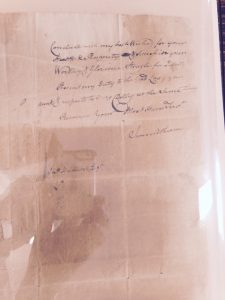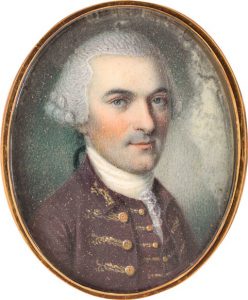I attended a meeting of the local Daughters of the American Revolution chapter this past Saturday, to support the accomplishment of this year’s Good Citizen essay contest winner. So far, students from the high school where I work have a three-for-three record of winning, and last year’s entrant even went on to win the state competition!
Along with the essay contest winner, her friend, and a couple of others, I was introduced as a guest … and was surprised that one lady commented on my blog posts for Vita Brevis. She mentioned that I might be a prospective member, probably recalling something I wrote several months ago that mentioned an ancestor’s connections to John Hancock.
Ironically, just the day before I attended the DAR meeting I’d read with great interest J. L. Bell’s “Boston 1775” blog post about miniatures of John Hancock and his two children being rediscovered. How exciting that the three portraits have been reunited![1]
But here’s the deal: while distant cousins became members of the DAR through James Athearn (1725–1814) of Tisbury, Martha’s Vineyard, he has since been “red-lined,” meaning that he is currently not recognized as a proven patriot. Of course this makes me sad and a little perplexed, given the documents that I have been able to locate – even from my location in the hinterlands of the West Coast.
First is the letter in the NEHGS collections, sent by John Hancock from Philadelphia and dated 22 June 1776. It is addressed to “James Athearn Esq. Commander in Chief in and over the Sons of Liberty in the free County of Dukes County,” and the final line is: “I shall write you further by Mr. Bant who sets out from this City to morrow.”
Two letters from William Bant (1738–1780) to John Hancock, which mention “Col. Athearn,” are included in Historical Manuscripts in the Public Library of the City of Boston, published in 1900. One was sent from Rehoboth on 25 March 1776: “I wrote to Col. Athearn this morning … I am now ready to go to Dartmouth, Martha’s Vineyard, and any, or every, where else that you may want on your Business…”
"I hope The time won’t be long before I may have ye Happiness of seeing you & the good Lady your aunt once more Settled in your once Pleasant & Peaceable Habitation."
The other was written from Boston and dated 19 October 1776. “I have had the pleasure of a Visit from Col. Athearn, inclosed you have a Letter from him, by which you will see that he has received of Capt. Kendrick[2] (who is gone on a Cruize against the Enemy) for your Account… [He] tells me he has wrote you fully what prospect he has of selling the other Vessells.”
These allusions to Colonel Athearn (likely an honorary title) and his handling of John Hancock’s economic interests perfectly coincide with the contents of several letters between John Hancock and James Athearn. The most interesting one was sent to John Hancock in Philadelphia and dated “Martha’s Vineyard 14 Septr 1775”:[3]
 “The Present Situation of Publick affairs in which you have Taken so Large a part Requires your Presence at Philadelphia therefore am Deprived of the Pleasure of your Company when I have been at Watertown &c.[4] I hope The time won’t be long before I may have ye Happiness of seeing you & the good Lady your aunt once more Settled in your once Pleasant & Peaceable Habitation.[5] Sir your Brig Undutied Tax, now Lies here.…
“The Present Situation of Publick affairs in which you have Taken so Large a part Requires your Presence at Philadelphia therefore am Deprived of the Pleasure of your Company when I have been at Watertown &c.[4] I hope The time won’t be long before I may have ye Happiness of seeing you & the good Lady your aunt once more Settled in your once Pleasant & Peaceable Habitation.[5] Sir your Brig Undutied Tax, now Lies here.…
“Upon Capt. Kendrick’s arrival he applied to me[.] I Thought he had best Lay the Vessel up at Nantuckett as being more Safe, but She is Still here …
“Conclude with my best Wishes for your Health & Prosperity & Success in your Worthy & Glorious Strugles for Liberty. Present my Duty to the Good Lady your Aunt[6] & respects to Miss Dolly[7] at the Same time.”
Dear Daughters of the American Revolution: I rest my case.
Notes
[1] The whole article, written by Pamela Ehrlich in Antiques and Fine Art magazine and at the “Incollect” site, can be found here.
[2] Capt. John Kendrick (1740–1794) commanded the privateer Fanny, which played a significant part in the Continental Navy. He was also reputedly a participant in the Boston Tea Party. In 1787, he and Capt. Robert Gray commanded the two vessels involved in the Columbia Expedition, the first circumnavigation of the globe by Americans.
[3] In the collections of the Martha’s Vineyard Museum.
[4] John Hancock and James Athearn were both elected to the Third Massachusetts Provincial Congress, which assembled at Watertown on 31 May 1775. However, John Hancock had also been elected to serve in the Second Continental Congress meeting in Philadelphia that same May, and therefore was not present in Watertown.
[5] The Hancock mansion in Boston had been damaged by British forces in April 1775, and was used as a hospital and also as the headquarters for General Henry Clinton.
[6] Lydia (Henchman) Hancock (1714–1776) helped rear the orphaned John Hancock, who became heir to her husband’s fortune and business.
[7] Dorothy Quincy (1747–1830) had just married John Hancock on 28 August, and the news evidently had not yet reached James Athearn on Martha’s Vineyard. With Lydia (Henchman) Hancock, she had been present at the commencement of hostilities at Lexington on 19 April that year.
Share this:

About Pamela Athearn Filbert
Pamela Athearn Filbert was born in Berkeley, California, but considers herself a “native Oregonian born in exile,” since her maternal great-great-grandparents arrived via the Oregon Trail, and she herself moved to Oregon well before her second birthday. She met her husband (an actual native Oregonian whose parents lived two blocks from hers in Berkeley) in London, England. She holds a B.A. from the University of Oregon, and has worked as a newsletter and book editor in New York City and Salem, Oregon; she was most recently the college and career program coordinator at her local high school.View all posts by Pamela Athearn Filbert →
